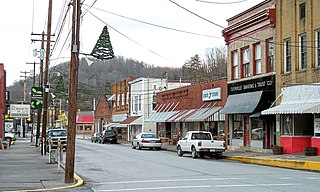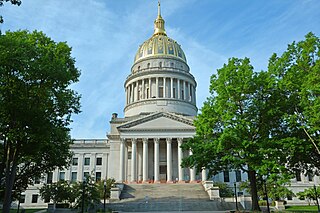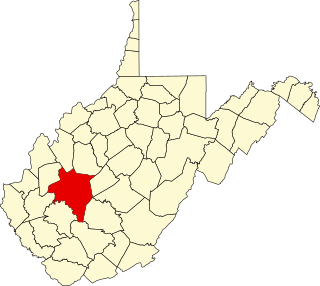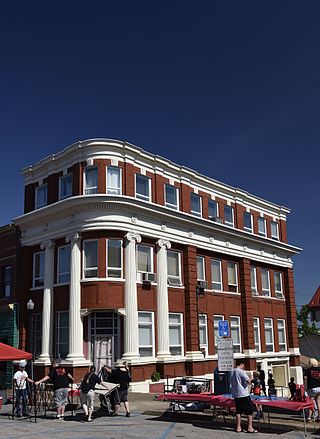
Charleston is the capital and most populous city of the U.S. state of West Virginia and the seat of Kanawha County. Located at the confluence of the Elk and Kanawha rivers, the city had a population of 48,864 at the 2020 census and an estimated population of 48,018 in 2021. The Charleston metropolitan area had 210,605 residents in 2020.

Glenville is a town in and the county seat of Gilmer County, West Virginia, United States, along the Little Kanawha River. The population was 1,128 at the 2020 census. It is the home of Glenville State University.

East Bank is a town in Kanawha County, West Virginia, United States, situated along the Kanawha River. The population was 820 at the 2020 census. East Bank was incorporated in 1889 by special charter enacted by the West Virginia Legislature. It is so named on account of the town's location on the east side of the Kanawha River.

Alum Creek is a census-designated place (CDP) in Kanawha and Lincoln counties along the Coal River in the U.S. state of West Virginia. It includes the unincorporated communities of Alum Creek, Forks of Coal, and Priestley. The CDP had a population of 1,749 at the 2010 census, down from 1,839 at the 2000 census.

The James River and Kanawha Canal was a partially built canal in Virginia intended to facilitate shipments of passengers and freight by water between the western counties of Virginia and the coast. Ultimately its towpath became the roadbed for a rail line following the same course.

The Coal River is a tributary of the Kanawha River in southern West Virginia. It is formed near the community of Alum Creek by the confluence of the Big and Little Coal Rivers, and flows generally northward through western Kanawha County, past the community of Upper Falls and into the Kanawha River at St. Albans.

The Grave Creek Mound in the Ohio River Valley in West Virginia is one of the largest conical-type burial mounds in the United States, now standing 62 feet (19 m) high and 240 feet (73 m) in diameter. The builders of the site, members of the Adena culture, moved more than 60,000 tons of dirt to create it about 250–150 BC.

The West Virginia State Capitol is the seat of government for the U.S. state of West Virginia, and houses the West Virginia Legislature and the office of the Governor of West Virginia. Located in Charleston, West Virginia, the building was dedicated in 1932. Along with the West Virginia Executive Mansion it is part of the West Virginia Capitol Complex, a historic district listed on the National Register of Historic Places.

Charleston station is an active intercity railroad station in Charleston, Kanawha County, West Virginia. Located on MacCorkle Avenue Southeast, the station services trains of Amtrak's Cardinal between New York Penn Station and Chicago Union Station. The two trains, make stops in Charleston on Wednesdays, Fridays and Sundays. Charleston station contains a single 800-foot (240 m) concrete side platform and has a station depot that provides a waiting room for customers.
Bulltown is an extinct town in Braxton County, West Virginia, United States. The GNIS classifies it as a populated place.
The Battle of Bulltown was a small skirmish fought during the American Civil War near Bulltown in Braxton County, West Virginia on October 13, 1863.

This is a list of the National Register of Historic Places listings in Kanawha County, West Virginia.
The Mountain Parkway Byway and Mountain Parkway Backway are two routes in northern Webster County, West Virginia. The Byway is a state-designated scenic byway which follows West Virginia Route 20 for 9.8 miles (15.8 km), traversing the headwaters of several mountain streams including the Right Fork Little Kanawha River, Jerry Run, and the Left and Laurel Forks of Holly River. The Backway explores backroads in the same area, is 32 miles (51 km) long, and follows stretches of the Right Fork Little Kanawha River and Left Fork Holly River for portions of its route.
Coalburg is an unincorporated community in Kanawha County, West Virginia, United States. Coalburg is located along the south bank of the Kanawha River, west of East Bank.

The Little Brick Church, also known as Virginia's Chapel and William Tompkins Church, is a historic church that sits along US Route 60 in Cedar Grove, Kanawha County, West Virginia. It was built in 1853, and is a small brick structure on a stone foundation. The building was nearly square when built, but lengthened within a few years. It features a louvered octagonal cupola, with finial. In 1912 a bell tower was added to the church. A mural behind the pulpit was painted by Forrest Hull in the early 1900s. The Chapel was occupied during the American Civil War by both sides. Originally a non-denominational chapel, it was for some time used exclusively by a Methodist congregation.

African Zion Baptist Church is a historic Baptist church at 4104 Malden Drive in Malden, Kanawha County, West Virginia. It is within the Malden Historic District.

The West Virginia Capitol Complex is an 18-acre (7.3 ha) historic district located along Kanawha Blvd., E., in Charleston, West Virginia. It dates from 1925 and was listed on the National Register of Historic Places in 1974.

Glen Ferris Inn, also known as Stockton's Inn, Stockton's Tavern, and Hawkins's Hotel, is a historic hotel located on the bank of the Kanawha River overlooking Kanawha Falls at Glen Ferris, Fayette County, West Virginia. It may have been built as early as 1815. It is a T-shaped brick building in two sections. One section is a three-story, painted brick dwelling. The second is a two-story, red brick wing measuring 140 by 40 feet. The building features a wraparound porch supported by 13 stuccoed brick columns. In the 19th century, the building was a stagecoach stop and served as a Union quartermaster's depot during the American Civil War. In the first half of the 20th century, it housed managers, supervisors, and workers involved in developing the area's manufacturing and hydro-electric capacity.

Bank of St. Albans Building, also known as St. Albans City Building, is a historic bank building located at St. Albans, Kanawha County, West Virginia. It was built in 1906, and is a three-story, masonry building in the Classical Revival style. The front facade features two sets of fluted columns with Ionic order capitals. It housed a bank until 1961, after which it was occupied by city offices.

"Oakland," also known as the James M. Stephenson House, is a home located in Parkersburg, Wood County, West Virginia. Although a slaveholder and sympathizing with the Confederacy, Stephenson was also married to the sister of Unionist Arthur Boreman, and allowed then Union Army Col. James B. Steedman to use his grove nearby during the American Civil War. However, Union cavalry units occupied this his mansion for a time nonetheless, and damaged furnishings as well as the home and garden.
















